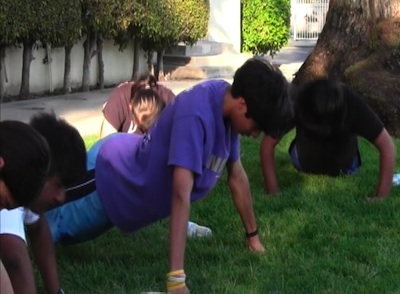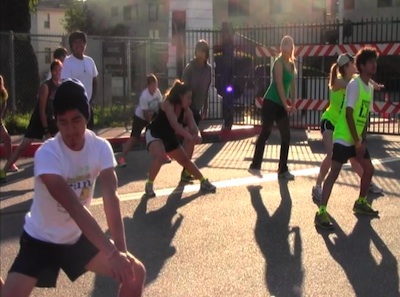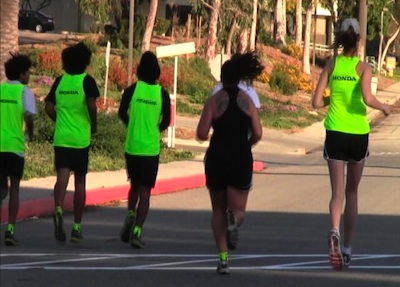By Jonathan Kendrick
The sun rises slowly, its first rays gradually illuminating the paint-chipped exterior walls of James A. Foshay Learning Center in South Los Angeles.
 It’s 6:30 a.m. on a mid-March Saturday morning—not the usual time for students to be arriving to their high school campus. Yet one by one they come: some yawning, others munching on a hurried breakfast, all ready to run.
It’s 6:30 a.m. on a mid-March Saturday morning—not the usual time for students to be arriving to their high school campus. Yet one by one they come: some yawning, others munching on a hurried breakfast, all ready to run.
There are only eight days until the 27th running of the Los Angeles Marathon, and the 10 high school students gathered in front of the school’s front entrance are in the final stages of their six month long preparation to compete in the race.
On this morning, the students and their five volunteer mentors pile into three cars and drive to the Los Angeles National Veterans Park, the starting point for their six mile run.
Upon arrival, team coach Shalom Sanchez leads the group through stretches before outlining the day’s course: north through Veterans Park, west along San Vicente Boulevard and then south down Ocean Avenue to the Santa Monica Pier.
For those students who competed in the marathon last year, this was the most difficult section of the course.
“I started off well for like the first 20 miles but after 21 miles my body broke down and I had to walk five miles in the rain,” said Jahiro Coreas, the team’s top runner, about the 2011 edition of the L.A. Marathon.
Students Run L.A.
 Foshay’s 10 student runners are part of a larger group of 3,000 students from 165 Southern California high schools, middle schools and community programs that train to run the marathon each year as a part of the Students Run L.A. (SRLA) program.
Foshay’s 10 student runners are part of a larger group of 3,000 students from 165 Southern California high schools, middle schools and community programs that train to run the marathon each year as a part of the Students Run L.A. (SRLA) program.
Nearly 50,000 students have trained with SRLA, which was an official Los Angeles Unified School District after-school program and now is its own independent non-profit organization, to run in the last 22 editions of the L.A. Marathon.
It all started with an East Los Angeles continuation high school teacher named Harry Shabazian, who trained for and ran the 1987 L.A. Marathon with some of his students.
Since then, the organization has made it its mission to “challenge at-risk secondary students to experience the benefits of goal-setting, character development, adult mentoring and improved health.” More than 95 percent of the high school seniors who run the marathon graduate and more than 90 percent have plans to attend college, according to the program’s web site.
“When students are involved and when students have something to buy into, they are going to be more motivated to do well,” said Foshay assistant principal Emilio Garza. “I think sometimes when you have these students who don’t participate in anything, obviously they feel disconnected from the campus, they don’t see a purpose for being here and as a result they’re just not going to put in as much effort into their class work.”
Training for a marathon is no easy task. Aside from the physical challenge of running 26.2 miles, Foshay students dedicate a large amount of time to training. The team practices together for more than two hours, three times per week after school from September to March. They add early morning Saturday sessions starting in November.
“I’m giving up time to study, time to just hang out with my friends, time to spend with my family,” said Foshay student and marathon runner Melissa Rojas. “But ultimately this program is showing me endurance so once this ends, I can do pretty much anything once I put my mind to it.”
Garza said that while after-school programs like training for the marathon can take up large amounts of the students’ time, they also inspire the participants to do well in school.
“The kids who want to play sports have to maintain above a certain GPA and they can’t get into trouble, otherwise we suspend them for games,” Garza said. “It is a motivating factor for the kids and I also think it is an opportunity for the kids to just do something that they are really passionate about on campus. I think it kind of just builds a positive feeling toward school and so it helps kids to continue to do well in school.”
Gearing Up to Run
 Less than 45 minutes after they set out from Veterans Park, the runners start to arrive at the designated meeting place, a grassy area overlooking the ocean near the Santa Monica Pier.
Less than 45 minutes after they set out from Veterans Park, the runners start to arrive at the designated meeting place, a grassy area overlooking the ocean near the Santa Monica Pier.
Coreas comes in first, displaying the seven-and-a-half-minute per mile speed he’ll show at the marathon the following week.
Once the whole team finishes the six mile course, they stretch together while discussing strategy for the marathon.
“You guys have made it,” Sanchez said. “You’ve trained hard. You’re ready.”
It’s then time for a surprise: a walk along the pier with stops to gaze out at the ocean’s horizon and pose for pictures with replicas of Forrest Gump’s running shoes.
“Some of these kids really haven’t been outside of their neighborhood very much,” Sanchez said. “But this program gets them outside of their neighborhood and gets them to see that they can accomplish things that they never really could imagine.”
To see the students now, having recently completed a 20-mile run, brings to a smile to Sanchez’s face as she remembers where the group started.
“It’s actually pretty amazing,” Sanchez said. “Some of the kids [during] the first couple of weeks in September were barely being able to run a mile. But they have really worked on their pace and sped up. They started slow and every week hit a new goal and every week saw that improvement. You saw a lot of them walking at first but then they saw that they could do it. It’s been kind of amazing to see them where they could barely run a mile to running 20.”
The students had to overcome various obstacles. For Coreas, it was about being disciplined in going to practice.
“I’ve been here almost every practice because last [year] I didn’t practice that much,” Coreas said. “I’ve actually been training harder and faster. I’ve been training my mind that I can’t break down that easily anymore. [During] most practices now I don’t stop [running] anymore. Last year I stopped a lot of times.”
For Armando Alva, cutting down on eating junk food was a top priority.
“I actually started eating better. Last year when I got home I just ate whatever because I just ran,” Alva said. “So this year I gave up soda and I feel like it’s helping me improve my speed and getting me in better shape. I was really fat [before training for the marathon] but I have lost weight and my time has improved a lot.”
For several of the students, it’s about carrying on even without a lot of encouragement from parents.
“This group of kids, they are so positive,” Sanchez said. “Some of them don’t have that support from families at home. And yet these kids really see this challenge and go for it. Most of these kids go on to college, continue running and continue with setting other goals, which a lot of other kids in this neighborhood don’t do. And the rate with our kids in finishing high school and even going into college is really, really high where the other kids in the school, the dropout rate is pretty high. Our kids go a different path which is really cool to see.”
Race Day and Beyond
With more than 23,000 runners tightly bunched in moving packs, it’s difficult to pick out the Foshay students from the crowd on L.A. Marathon race day. They are there – some running faster than others, but all determined to finish.
Coreas finished the marathon in three hours and 19 minutes, Alva in four hours and 41 minutes, Coach Sanchez in four hours and 43 minutes.
It marked the end of a six-month journey to run a marathon, a task that seemed unreachable for some of the students at the start of the school year. It also marked the beginning of a new journey, as the marathon-runners made plans for the future.
“We talk about setting commitments, setting goals and what that means in their life, not only with running but what that could mean for them with scholastics or families or any other goal that they might have in their life,” Sanchez said. “We try to show them how they can apply what they learned through the marathon training to anything in their life.”
Adriana Ocampo, for one, wants to continue running.
“I don’t want to stop running because it’s healthy and it relaxes me,” Ocampo said. “It takes away stress.”
The marathon-running students have big goals for after high school. Rojas hopes to attend a four-year university and major in environmental engineering, while Alva plans to move to New York and study German linguistics in college.
“Our coaches are so great. They taught us how to set goals and how to accomplish those goals, not just set them and leave them there,” Alva said. “I’m going to use the skills I learned here and apply those to my academics to achieve those goals.”














